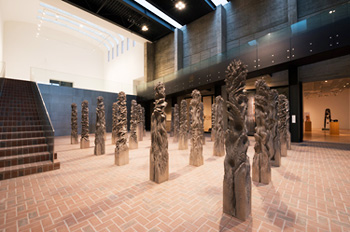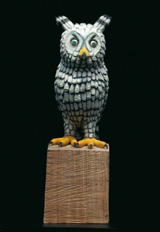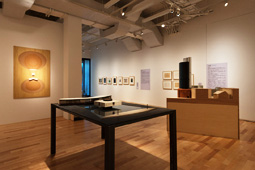 |
 |
Focus features two in-depth reviews each month of fine art, architecture and design exhibitions and events at art museums, galleries and alternative spaces around Japan. The contributors are non-Japanese art critics living in Japan. |
|
|
 |
 |
 |
"Even in Utopia, I Am There"
Nicolai Kruger |
 |
 |
|
 |
|
|
|
Woods IX (2008) by Shigeo Toya, one of Japan's most renowned contemporary sculptors, who uses a chainsaw to carve his delicate pieces. Photo by Tadasu Yamamoto
|
|
Bird 2010-02 (2010) by the acclaimed contemporary sculptor Atsuhiko Misawa is part of his ongoing study of animals (wood-carved, painted in oil). Photo by Masako Nagano
|
The Musashino Art University Museum & Library by architect Sou Fujimoto was completed in 2010. Located on the lush grounds of the university's Kodaira campus, it is on the must-see list for aspiring architects visiting greater Tokyo. The new library was built adjacent to the former library building, which, as part of the project, has been refurbished and now serves as the university's art museum. In an effort to assure a smooth flow between the buildings and their functions, Fujimoto succeeds at creating an integrated experience. For the museum wing, a dramatic stair and scissoring slope wrap around the main exhibition hall. Of the new library wing, Fujimoto says in an interview, "I imagined a place encircled by a single bookshelf in the form of a spiral." The concept of a building made out of a bookcase was realized quite literally, symbolizing a "vessel" to house precious books and art.
Being that a tomb is also a vessel -- a literal resting place for the dead and a tangible marker for remembrance -- it seems fitting that "tombs" are the theme of the Museum & Library's current exhibition, Et in Arcadia Ego, The Hidden Place Called "Sculpture." The title translates to "Even in utopia, I am there," and "I" may be perceived as death or the inevitable. The exhibition brings together a diverse selection of works from ancient Italy, 20th-century masters, and artists practicing today. Starting with monuments to the dead, the show poses the question, "What does sculpture reveal?"
The exhibition is arranged loosely in two parts. The first is an homage to four celebrated and influential artists of the 20th century: the Swiss sculptor and painter Alberto Giacometti (1901-66), best known for his dramatically attenuated human figures in bronze; Isamu Wakabayashi (1936-2003), a Japanese sculptor known for his works in iron, copper and lead; the prolific Japanese-American sculptor and landscape designer Isamu Noguchi (1904-88); and Seiichi Shirai (1905-83), the distinguished Japanese architect, philosopher and poet. On center in this space are models of unrealized proposals for Memorial to the Dead, Hiroshima (designed in 1952) and Temple [of] Atomic Catastrophes (designed in 1953), by Noguchi and Shirai respectively. Also within this portion of the exhibition is a special room dedicated to precious stone sculptures from crypts of the Etruscan era (768-264 BCE, in modern-day Umbria, Italy). The Etruscans were devoted to religious observances and funerary rituals, and their sculptures were strictly for these purposes.
 |
|
 |
|
|
|
| Viewers admire a recent tile installation by sculptor Kenjiro Okazaki filling one entire exhibition space at Musashino Art University Museum & Library. Photo by Ken Kato |
|
Models of the unrealized submission for the Temple of Atomic Catastrophes by Seiichi Shirai (designed in 1953). The 1:50 scale building model and 1:200 scale site model (wall-mounted) were created especially for this exhibition by Musashino Art University in 2013. Photo by Ken Kato
Photographs courtesy of the Musashino Art University Museum & Library.
|
The ancient tomb sculptures and the 20th-century masterworks are intended to provide context for the second part of the exhibition, which features new works by seven contemporary Japanese sculptors in a variety of media and scales. Unlike the first part, which resides in its own dedicated space, these conceptual works are presented throughout the museum, and a few pieces, including Bird 2010-02 (2010) by Atsuhiko Misawa, are situated outside. Large-scale works like the painted-tile installation by Kenjiro Okazaki fill an entire exhibit space. Shigeo Toya's Woods IX (2008) is a poetic installation of 30 human-scale wood carvings arranged in a grid in the central display space. With their rich, delicate texture, they seem like abstract Bodhisattvas, suggesting a ritualistic purpose. Other contemporary artists featured include Toshikatsu Endo, Hiroki Kurokawa, Makoto Ito, and Eri Takayanagi.
The sequence and selection of works seems a bit disparate at points. There are three other separate shows going on concurrently with Et in Arcadia Ego, and a visitor would therefore be forgiven for asking, "Is this part of the exhibit?" For those who do not read Japanese, the show's concept is inaccessible. Neither titles of the works on display nor the artists' names are shown in romanized text, and there is no exhibition summary available in English. Nevertheless, the show is still captivating and the individual pieces on display -- tangible embodiments of devotion -- are deeply thought-provoking.
 |
 |
Nicolai Kruger, AIA
Nicolai Kruger is an architect managing international projects at Pelli Clarke Pelli Architects, Japan. She has been living in Tokyo since 2006. She received her BFA in Design at Cornish College of the Arts in Seattle, followed by her Masters of Architecture at the University of Oregon. Her principal areas of interest include mixed-use, temporary structures, exhibition and lighting design. |
|
 |
|
|
 |
|
 |
|